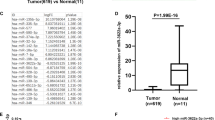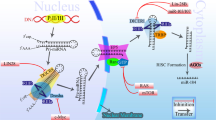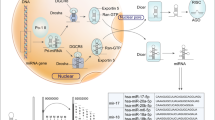Abstract
Dysregulated expression of microRNAs (miRNAs) is associated with a variety of diseases, including colorectal cancer. By comparing more than 200 miRNAs in 13 pairs of matched colorectal cancer and normal adjacent tissue samples through qRT-PCR and microarray analysis, we found a widespread disruption of miRNA expression during colorectal tumorigenesis. In particular, among a panel of presumed targets generated by in silico analysis that may interact with these aberrantly expressed miRNAs, KRAS oncogene has been further experimentally validated as the target of miR-143. First, an inverse correlation between KRAS protein and miR-143 in vivo was found. Second, KRAS expression in Lovo cells was significantly abolished by treatment with miR-143 mimic, whereas miR-143 inhibitor increased KRAS protein level. Third, luciferase reporter assay confirmed that miR-143 directly recognize the 3′-untranslated region of KRAS transcripts. Four, Lovo cells treated with miR-143 inhibitor showed a stimulated cell proliferation, whereas miR-143 overexpression had an opposite effect. Finally, inhibition of KRAS expression by miR-143 inhibits constitutive phosphorylation of ERK1/2. Taken together, the present study provides the first evidences that miR-143 is significant in suppressing colorectal cancer cell growth through inhibition of KRAS translation.
This is a preview of subscription content, access via your institution
Access options
Subscribe to this journal
Receive 50 print issues and online access
$259.00 per year
only $5.18 per issue
Buy this article
- Purchase on SpringerLink
- Instant access to full article PDF
Prices may be subject to local taxes which are calculated during checkout



Similar content being viewed by others
References
Akao Y, Nakagawa Y, Naoe T . (2006). let-7 microRNA functions as a potential growth suppressor in human colon cancer cells. Biol Pharm Bull 29: 903–906.
Bandres E, Cubedo E, Agirre X, Malumbres R, Zarate R, Ramirez N et al. (2006). Identification by real-time PCR of 13 mature microRNAs differentially expressed in colorectal cancer and non-tumoral tissues. Mol Cancer 5: 29.
Calin GA, Croce CM . (2006). MicroRNA signatures in human cancers. Nat Rev Cancer 6: 857–866.
Calin GA, Sevignani C, Dan Dumitru C, Hyslop T, Noch E, Yendamuri S et al. (2004). Human microRNA genes are frequently located at fragile sites and genomic regions involved in cancers. Proc Natl Acad Sci USA 101: 2999–3004.
Chen CF, Ridzon DA, Broomer AJ, Zhou ZH, Lee DH, Nguyen JT et al. (2005). Real-time quantification of microRNAs by stem-loop RT–PCR. Nucleic Acids Res 33: e179.
Cummins JM, He Y, Leary RJ, Pagliarini R, Diaz Jr LA, Sjoblom T et al. (2006). The colorectal microRNAome. Proc Natl Acad Sci USA 103: 3687–3692.
Eisen MB, Spellman PT, Brown PO, Botstein D . (1998). Cluster analysis and display of genome-wide expression patterns. Proc Natl Acad Sci USA 95: 14863–14868.
Esau C, Kang XL, Peralta E, Hanson E, Marcusson EG, Ravichandran LV et al. (2004). MicroRNA-143 regulates adipocyte differentiation. J Biol Chem 279: 52361–52365.
Esquela-Kerscher A, Slack FJ . (2006). Oncomirs—microRNAs with a role in cancer. Nat Rev Cancer 6: 259–269.
Fang JY, Richardson BC . (2005). The MAPK signalling pathways and colorectal cancer. Lancet Oncol 6: 322–327.
He L, Hannon GJ . (2004). MicroRNAs: small RNAs with a big role in gene regulation. Nat Rev Genet 5: 522–531.
Jemal A, Murray T, Ward E, Samuels A, Tiwari RC, Ghafoor A et al. (2005). Cancer statistics, 2005. CA Cancer J Clin 55: 10–30.
John B, Enright AJ, Aravin A, Tuschl T, Sander C, Marks DS . (2004). Human microRNA targets. PLoS Biol 2: 1862–1879.
Johnson SM, Grosshans H, Shingara J, Byrom M, Jarvis R, Cheng A et al. (2005). RAS is regulated by the let-7 microRNA family. Cell 120: 635–647.
Krek A, Grun D, Poy MN, Wolf R, Rosenberg L, Epstein EJ et al. (2005). Combinatorial microRNA target predictions. Nat Genet 37: 495–500.
Lewis BP, Shih IH, Jones-Rhoades MW, Bartel DP, Burge CB . (2003). Prediction of mammalian microRNA targets. Cell 115: 787–798.
Lim LP, Lau NC, Garrett-Engele P, Grimson A, Schelter JM, Castle J et al. (2005). Microarray analysis shows that some microRNAs downregulate large numbers of target mRNAs. Nature 433: 769–773.
Liu CG, Calin GA, Meloon B, Gamliel N, Sevignani C, Ferracin M et al. (2004). An oligonucleotide microchip for genome-wide microRNA profiling in human and mouse tissues. Proc Natl Acad Sci USA 101: 9740–9744.
Michael MZ, O’Connor SM, Pellekaan NGV, Young GP, James RJ . (2003). Reduced accumulation of specific microRNAs in colorectal neoplasia. Mol Cancer Res 1: 882–891.
Michor F, Iwasa Y, Lengauer C, Nowak MA . (2005). Dynamics of colorectal cancer. Semin Cancer Biol 15: 484–493.
Schetter AJ, Leung SY, Sohn JJ, Zanetti KA, Bowman ED, Yanaihara N et al. (2008). MicroRNA expression profiles associated with prognosis and therapeutic outcome in colon adenocarcinoma. JAMA 299: 425–436.
Tang FC, Hajkova P, Barton SC, Lao KQ, Surani MA . (2006). MicroRNA expression profiling of single whole embryonic stem cells. Nucleic Acids Res 34: e9.
Thomson JM, Parker J, Perou CM, Hammond SM . (2004). A custom microarray platform for analysis of microRNA gene expression. Nat Methods 1: 47–53.
Tusher VG, Tibshirani R, Chu G . (2001). Significance analysis of microarrays applied to the ionizing radiation response. Proc Natl Acad Sci USA 98: 5116–5121.
Volinia S, Calin GA, Liu CG, Ambs S, Cimmino A, Petrocca F et al. (2006). A microRNA expression signature of human solid tumors defines cancer gene targets. Proc Natl Acad Sci USA 103: 2257–2261.
Welch C, Chen Y, Stallings RL . (2007). MicroRNA-34a functions as a potential tumor suppressor by inducing apoptosis in neuroblastoma cells. Oncogene 26: 5017–5022.
Acknowledgements
We thank Yun Luo for pathological diagnosis and sample collection. This work was supported by National Natural Science Foundation of China (nos. 30225037, 30471991 and 30570731); 973 Program of China (nos. 2006CB503909 and 2004CB518603) and Natural Science Foundation of Jiangsu province (nos. BK2004082 and BK2006714).
Author information
Authors and Affiliations
Corresponding authors
Additional information
Supplementary Information accompanies the paper on the Oncogene website (http://www.nature.com/onc)
Supplementary information
Rights and permissions
About this article
Cite this article
Chen, X., Guo, X., Zhang, H. et al. Role of miR-143 targeting KRAS in colorectal tumorigenesis. Oncogene 28, 1385–1392 (2009). https://doi.org/10.1038/onc.2008.474
Received:
Revised:
Accepted:
Published:
Issue Date:
DOI: https://doi.org/10.1038/onc.2008.474
Keywords
This article is cited by
-
Blood-based microRNA profiling unveils complex molecular dynamics in breast cancer
Journal of Applied Genetics (2024)
-
Novel insights on perils and promises of miRNA in understanding colon cancer metastasis and progression
Medical Oncology (2023)
-
Emerging role of non-coding RNAs in the regulation of KRAS
Cancer Cell International (2022)
-
KRAS-related long noncoding RNAs in human cancers
Cancer Gene Therapy (2022)
-
Hsa-miR-143-3p inhibits Wnt-β-catenin and MAPK signaling in human corneal epithelial stem cells
Scientific Reports (2022)



